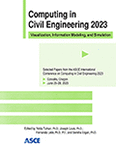Design Support Engine for Mass Engineered Timber Buildings
Publication: Computing in Civil Engineering 2023
ABSTRACT
Recent developments in data modeling provide the means of aligning model information between competencies. However, due to different problem-solving approaches between disciplines, this is not sufficient to permit cross domain reasoning. A higher level of semantics is necessary for concept transfer between expertise domains. Our research defines a milieu for creating conceptual frameworks across architectural and structural design of cross laminated timber (CLT) and other mass engineered timber (MET) buildings through modeling explicit functional relationships between building components and design task tracking. MET products are a reliable and cost-effective alternative for mid-rise construction due to their resilience and suitability for prefabrication. Moreover, the maturing North American forestry stock ensures onshore resource availability for the US AEC industry. With this approach, graph-based internal conceptual models are explicitly represented to support decision making and design interaction tracking. Methods are demonstrated through flexible space allocation, structural design adaptable to global geometry at the component level, and an explicit informative layer where domain knowledge and decisions are declared. Moreover, the graph structure can be used to localize change tracking, aiding in version control. Finally, a case library prototype is demonstrated with the intent of disseminating best practice solutions in this new construction medium and facilitating their applications for learning practitioners.
Get full access to this article
View all available purchase options and get full access to this chapter.
REFERENCES
Pomponi, F., J. Hart, J. H. Arehart, and B. D’Amico. (2020). “Buildings as a global carbon sink? A reality check on feasibility limits.” One Earth 3(2): 157–161.
Haddad, B. (2022). Construction estimating challenges after COVID 19-the effect of price escalation and material shortages on construction cost and contract management, Industry, Engineering & Conference Management Systems Conference.
Organschi, A., A. Ruff, C. D. Oliver, C. Carbone, and E. Herrmann. (2016). Timber city: Growing an urban carbon sink with glue, screws, and cellulose fiber.
Mora, R., H. Rivard, and C. Bédard. (2006). “Computer representation to support conceptual structural design within a building architectural context.” Journal of Computing in Civil Engineering 20(2): 76–87.
Do, E. Y.-L., and M. D. Gross. (2001). “Thinking with diagrams in architectural design.” Artificial Intelligence Review 15: 135–149.
Bermek, M. S., D. Shelden, and R. Gentry. (2019). Schema for Automated Generation of CLT Framing and Panelization. Computing in Civil Engineering 2019: Visualization, Information Modeling, and Simulation, American Society of Civil Engineers Reston, VA: 312–319.
Bermek, M. S., D. Shelden, and T. R. Gentry. (2019). A Holistic Approach to Feature-based Structural Mapping in Cross Laminated Timber Buildings.
Eastman, C. M. (1973). “Automated space planning.” Artificial intelligence 4(1): 41–64.
Okhoya, V. W., M. Bernal, A. Economou, N. Saha, R. Vaivodiss, T.-C. K. Hong, and J. Haymaker. (2022). “Generative workplace and space planning in architectural practice.” International Journal of Architectural Computing 20(3): 645–672.
Weber, R. E., C. Mueller, and C. Reinhart. (2022). “Automated floorplan generation in architectural design: A review of methods and applications.” Automation in Construction 140: 104385.
Grobler, F., A. Aksamija, H. Kim, R. Krishnamurti, K. Yue, and C. Hickerson. (2008). Ontologies and shape grammars: communication between knowledge-based and generative systems. Design Computing and Cognition'08: Proceedings of the Third International Conference on Design Computing and Cognition, Springer.
Aksamija, A., K. Yue, H. Kim, F. Grobler, and R. Krishnamurti. (2010). “Integration of knowledge-based and generative systems for building characterization and prediction.” Ai Edam 24(1): 3–16.
Aish, R., W. Jabi, S. Lannon, N. Wardhana, and A. Chatzivasileiadi. (2018). Topologic: tools to explore architectural topology.
Lee, G., R. Sacks, and C. M. Eastman. (2006). “Specifying parametric building object behavior (BOB) for a building information modeling system.” Automation in construction 15(6): 758–776.
Cavieres, A. (2018). A functional modeling framework for interdisciplinary building design.
Mora, R., C. Bédard, and H. Rivard. (2008). “A geometric modelling framework for conceptual structural design from early digital architectural models.” Advanced Engineering Informatics 22(2): 254–270.
Ondrej, and Abell. (2012). Import IFC into SAP2000 CSi Knowledge Base, CSI.
Wan, C., P.-H. Chen, and R. L. Tiong. (2004). “Assessment of IFCs for structural analysis domain.” Journal of Information Technology in Construction (ITcon) 9(5): 75–95.
Eastman, C., D. S. Parker, and T.-S. Jeng. (1997). “Managing the integrity of design data generated by multiple applications: The principle of patching.” Research in engineering design 9(3): 125–145.
van Berlo, L., H. Tauscher, T. Liebich, A. van Kranenburg, and P. Paasiala. (2021). Future of the Industry Foundation Classes: towards IFC 5.
Information & Authors
Information
Published In
History
Published online: Jan 25, 2024
ASCE Technical Topics:
- Architectural engineering
- Building design
- Building information modeling
- Building management
- Building materials
- Construction engineering
- Construction management
- Design (by type)
- Detection methods
- Engineering fundamentals
- Engineering materials (by type)
- Engines
- Equipment and machinery
- Materials engineering
- Methodology (by type)
- Structural design
- Structural engineering
- Structures (by type)
- Tracking
- Wood and wood products
- Wood structures
Authors
Metrics & Citations
Metrics
Citations
Download citation
If you have the appropriate software installed, you can download article citation data to the citation manager of your choice. Simply select your manager software from the list below and click Download.
